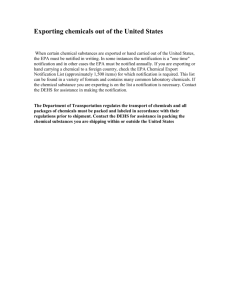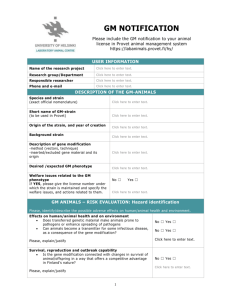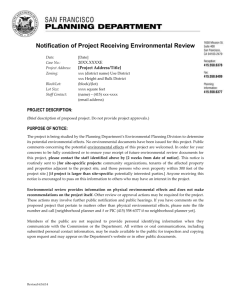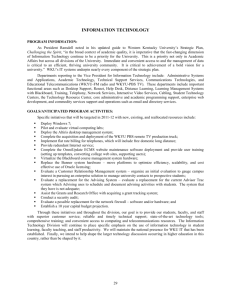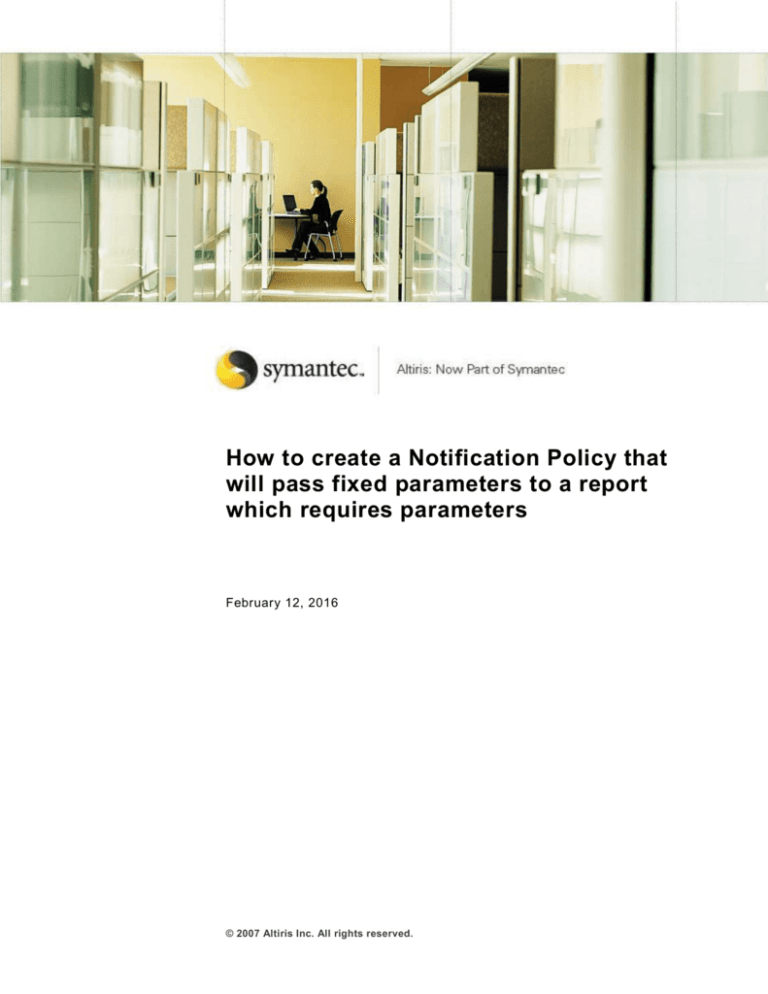
How to create a Notification Policy that
will pass fixed parameters to a report
which requires parameters
February 12, 2016
© 2007 Altiris Inc. All rights reserved.
ABOUT ALTIRIS
Altiris, Inc. is a pioneer of IT lifecycle management software that allows
IT organizations to easily manage desktops, notebooks, thin clients,
handhelds, industry-standard servers, and heterogeneous software
including Windows, Linux, and UNIX. Altiris automates and simplifies IT
projects throughout the life of an asset to reduce the c ost and complexity
of management. Altiris client and mobile, server, and asset management
solutions natively integrate via a common W eb -based console and
repository. For more information, visit www.altiris.com.
NOTICE
INFORMATION IN THI S DO CUMENT: ( I) IS PRO VIDED FOR I NFORMATIONAL PURPOSES O NLY W ITH
RESPECT TO PRODUCTS OF ALTIRI S OR ITS SUBSI DIARI ES (“PRODUCT S”), (II) REPRESENTS ALTIRI S’
VIEW S AS OF THE DAT E OF PUBLICATION OF THIS DO CUMENT, (III) IS SUBJECT TO CHANGE W ITHOUT
NOTICE, AND (I V) SHO ULD NOT BE CONSTRUED AS ANY CO MMIT MENT BY ALTIRI S. EXCEPT AS PROVI DED
IN ALTIRI S’ LICENSE AGREEMENT GOVERNING ANY PRO DUCTS OF ALTI RIS OR IT S SUBSIDIARIES
(“PRODUCT S”), ALTIRIS ASSUMES NO LIABILIT Y W HATSOEVER, AND DI SCLAI MS ANY EXPRESS OR IMPLIED
W ARRANTIES RELATING TO THE USE OF ANY PRODUCT S, INCL UDING W ITHOUT LIMITATION, W ARRANTIES
OF FITNESS FOR A PARTICULAR PURPOSE, MERCHANTABILITY, O R INF RINGEMENT OF ANY THIRD PARTY
INTELLECTUAL PROPERTY RIGHTS. ALTIRIS ASSUMES NO RES PO NSI BIL ITY FOR ANY ERRORS OR
OMISSIONS CO NTAINED IN THI S DO CUMENT AND ALTIRIS SPECIFICALL Y DISCLAI MS ANY AND ALL
LIABILITIES AND/O R OBLIG ATIONS F OR ANY CL AIMS, SUITS O R DAMAGES ARI SING FRO M O R IN
CONNECTION W ITH THE USE OF, RELIANCE UPON OR DISSEMINATION O FTHIS DOCUMENT AND/OR THE
INFORMATION CO NTAINED HEREIN.
Altiris may ha ve patents or pending patent applications, trademarks, cop yrights, or other intellectual property
rights that relate to the Products referenced herein. The furnishing of this docu ment and other materials and
information does not provide any license, express or i mplied, by estoppel or otherwise, to any foregoing
intellectual property rights.
No part of this docu ment may be reproduced, stored in a retrieval system, or transmitted in any form or by any
means without the e xpress written con sent of Altiris, Inc.
Custo mers are solely responsible for assessing the suitability of the Products for use in particular applications.
Products are not intended for use in medical, life saving, life s ustaining, critical control or safety systems, or in
nuclear facility applications.
Copyright © 2006, Altiris, Inc. All rights reserved.
Altiris, Inc.
588 W est 400 South
Lindon, UT 84042
Phone: (801) 226-8500
Fax: (801) 226-8506
*Other co mpany na me s or products me ntioned are or may be trade marks of th eir respective owners.
Infor mation in this document is sub ject to change without notice. For the latest docu mentation, visit
www.altiris.com.
www.altiris.com
CONTENTS
Introduction ................................................................................... 1
Method A ....................................................................................... 2
Method B ....................................................................................... 7
www.altiris.com
INTRODUCTION
In some cases you may want to create a Notification Policy that will
execute a report and send the results to a specific user or group of
users. The problem is that some reports require input at the time of
execution.
The following document will detail two examples of how to accomplish
this. The main purpose of this document is not to give you all the
answers on how to do this, but to give you a clear example of how to do
this. It is up to you then to build upon what is detailed in this document.
For this exampl,e we are going to use the report from Patch Management
Solution called Microsoft Compliance and Vulnerability by Bulletin —
Details.
www.altiris.com
How to create a Notification Policy that will pass fixed parameters > 1
METHOD A
This method will give you the ability to create a Notification Policy on the
Notification Server which will run the report Microsoft Compliance and
Vulnerability by Bulletin—Details, and then will pass coded parameters
defined in the policy to this report. Once that is complete it will email the
users a link to the results of this report.
To begin, it is necessary to find the parameters that the report requires
at run time. In order to do this you must clone the report and also run the
report so you can see some of the values that are required.
Once the report is cloned and run in a new window you will want to edit
the report.
The following screen shot is a good example of the values that are going
to be needed:
You will notice from the screen shot below there are several parameters
you need to review in this report:
2 < How to create a Notification Policy that will pass fixed parameters
www.altiris.com
The Global Parameters from this report is what you will need to hard
code on the parameters of the Notification Policy that is going to be
created later on.
You will have to change these parameters to a fixed entry.
_Collection: This parameter becomes an actual GUID of a collection.
_StartDate: You can use a SQL query here that would return a
specific date when executed. Such a query would look like this:
SELECT CONVERT(nvarchar(10),DATEADD(yy, -1,GETDATE()),101)
That query will get the current date and subtract one year from it.
That value will be used as the StartDate parameter.
_EndDate: You can also use a SQL query here that would return a
specific date when executed. Such a query might look like this:
SELECT CONVERT(nvarchar(10),GETDATE(),101)
www.altiris.com
That query would return the current date.
_VendorSeverity: The options for this particular parameter happen to
be Critical, Important, Moderate, Low, Unclassified, or Any.
Therefore, when creating this entry, you could enter in any of those
values except the value of Any. To translate the value of Any, you
would have to use a % entry.
_CustomSeverity: Normally this could be created with a value of %.
_DistributionStatus: This would be created with either Active or All.
_SupersedenceStatus: You could go with a value of % or just All.
_OperatingSystem: The value here would be the name of the
Operating System. For example: Microsoft W indows Server 2003.
How to create a Notification Policy that will pass fixed parameters > 3
The last two parameters shown in the screen shot would not need to be
edited due to the fact that they are not parameters that require input
during report execution time.
Now that you have the values you are going to need you would now
create your Notification Policy.
With the newly created Notification Policy you would change the Source
dropdown to the value of Query.
Click on the Edit Query link and choose the option to enter SQL directly.
Enter in a value of something like SELECT 1 or some other garbage
query. This is not used in the policy and is just a place holder type value.
Now click on Edit Parameters.
You will need to enter in each parameter with its set value that you
figured out earlier in these parameters.
Pay special attention to the Type value in the screen shot above. You
will want to use similar values.
Once you have entered in your parameters the next step is to j ust add a
Report Automated Action under the Automated Actions section.
4 < How to create a Notification Policy that will pass fixed parameters
www.altiris.com
Once complete please test your notification policy. Your To Address
should receive an email from the Notification Server with a link to view
the results of the report.
www.altiris.com
How to create a Notification Policy that will pass fixed parameters > 5
6 < How to create a Notification Policy that will pass fixed parameters
www.altiris.com
METHOD B
This method is very much like method A, with the exception that you will
be cloning the report and this time editing it and giving it a new name.
The notification policy will then not have any parameters entered to pass
and will just run the newly created report. This report will have the values
already hard coded inside it.
The other main difference is that this method will send an email to the
desired users with the results already inside the email. This is useful if
the report results are minimal, because it does not require the end users
receiving the email to load the report URL. Therefore, the end users do
not need the ActiveX controls installed on their computers.
As described in Method A, you will want to clone and then finally e dit the
report in question.
For each global parameter change them to a coded value. The same
coded values described in method A can be used here.
Once you have the report all done you should actually run the report one
time to ensure it runs as expected. If so you are ready to create your
Notification Policy.
www.altiris.com
How to create a Notification Policy that will pass fixed parameters > 7
Now go ahead and create your Notification Policy.
In the Source drop down you will want to have Report chosen and then
click on the Select a report link. Navigate to your customized report that
you created earlier and select it.
Under the Automated Actions section you need to choose E-mail
Automated Action.
Review the screen shot above for the specific important details. You will
notice that you should set the Execute to Only Once option.
It is also important to note the Message part of the screenshot above. It
is very important you enter in %Results%. The R must be capital.
You can, if you wish, add some additional verbiage below the %Results%
entry.
Now save your Notification Policy and test it.
8 < How to create a Notification Policy that will pass fixed parameters
www.altiris.com



